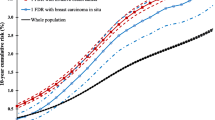Abstract
Risk factors for breast carcinoma in situ and invasive breast cancer were compared using data from 61,844 women (61% post-menopausal) with no prior breast cancer and at least one screening mammogram between April 1, 1996 and June 30, 2001. The women were followed until a subsequent mammogram before July 1, 2001, or a benign biopsy or breast cancer diagnosis before June 30, 2002. A total of 1,191 breast cancers (300 in situ and 891 invasive) were diagnosed during an average follow-up of 3.1 years. Multivariate Cox regression models were used to estimate the relative risks (RR) of in situ and invasive cancer associated with family history of breast cancer, age at first childbirth or nulliparity, post-menopausal hormone use, body mass index (BMI), and mammographic breast density. Separate analyses were done for pre- and post-menopausal women. BMI was unrelated to risk of in situ cancer regardless of menopausal status, but was associated with an increased risk of invasive cancer in post-menopausal women (RR = 1.9 for BMI ≥ 30 vs. BMI < 22, 95% confidence interval 1.4–2.5). Later childbearing and nulliparity were more strongly associated with in situ than invasive cancer in pre-menopausal women. Post-menopausal hormone use was more strongly associated with invasive disease. RR associated with family history and breast density were similar for in situ cancer and invasive cancer. Results indicating that BMI is related to post-menopausal invasive cancers but unrelated to in situ cancers are consistent with the hypothesis that concomitants of obesity activate proliferation.
Similar content being viewed by others
Explore related subjects
Discover the latest articles and news from researchers in related subjects, suggested using machine learning.References
Ernster VL, Ballard-Barbash R, Barlow WE et al (2002) Detection of ductal carcinoma in situ in women undergoing screening mammography. J Natl Cancer Inst 94:1546–1554
Levi F, Randimbison L, Te VC, La Vecchia C (2005) Invasive breast cancer following ductal and lobular carcinoma in situ of the breast. Int J Cancer 116:820–823
Warren JL, Weaver DL, Bocklage T (2005) The frequency of ipsilateral second tumors after breast-conserving surgery for DCIS: a population based analysis. Cancer 104:1840–1848
Sanders ME, Schuyler PA, Dupont WD, Page DL (2005) The natural history of low-grade ductal carcinoma in situ of the breast in women treated by biopsy only revealed over 30 years of long-term follow-up. Cancer 103:2481–2484
Cui Y, Whiteman MK, Flaws JA, Langenberg P, Tkaczuk KH, Bush TL (2002) Body mass and stage of breast cancer at diagnosis. Int J Cancer 98:279–283
Hunt KA, Sickles EA (2000) Effect of obesity on screening mammography: outcomes analysis of 88,346 consecutive examinations. AJR Am J Roentgenol 174:1251–1255
Loi S, Milne RL, Friedlander ML (2005) Obesity and outcomes in premenopausal and postmenopausal breast cancer. Cancer Epidemiol Biomarkers Prev 14:1686–1691
Enger SM, Greif JM, Polikoff J, Press M (2004) Body weight correlates with mortality in early-stage breast cancer. Arch Surg 139:954–958; discussion 958–960
Whiteman MK, Hillis SD, Curtis KM, McDonald JA, Wingo PA, Marchbanks PA (2005) Body mass and mortality after breast cancer diagnosis. Cancer Epidemiol Biomarkers Prev 14:2009–2014
Senie RT, Rosen PP, Rhodes P, Lesser ML, Kinne DW (1992) Obesity at diagnosis of breast carcinoma influences duration of disease-free survival. Ann Intern Med 116:26–32
Habel LA, Dignam JJ, Land SR, Salane M, Capra AM, Julian TB (2004) Mammographic density and breast cancer after ductal carcinoma in situ. J Natl Cancer Inst 96:1467–1472
Stoll BA (2000) Adiposity as a risk determinant for postmenopausal breast cancer. Int J Obes Relat Metab Disord 24:527–533
Stoll BA (2002) Oestrogen/insulin-like growth factor-I receptor interaction in early breast cancer: clinical implications. Ann Oncol 13:191–196
Goodwin PJ, Ennis M, Pritchard KI et al (2002) Fasting insulin and outcome in early-stage breast cancer: results of a prospective cohort study. J Clin Oncol 20:42–51
Vacek PM, Geller BM (2004) A prospective study of breast cancer risk using routine mammographic breast density measurements. Cancer Epidemiol Biomarkers Prev 13:715–722
Geller BM, Worden JK, Ashley JA, Oppenheimer RG, Weaver DL (1996) Multipurpose statewide Breast Cancer Survelliance System: the Vermont experience. J Regist Manag 23:168–174
Trentham-Dietz A, Newcomb PA, Storer BE, Remington PL (2000) Risk factors for carcinoma in situ of the breast. Cancer Epidemiol Biomarkers Prev 9:697–703
Kerlikowske K, Barclay J, Grady D, Sickles EA, Ernster V (1997) Comparison of risk factors for ductal carcinoma in situ and invasive breast cancer. J Natl Cancer Inst 89:76–82
Longnecker MP, Bernstein L, Paganini-Hill A, Enger SM, Ross RK (1996) Risk factors for in situ breast cancer. Cancer Epidemiol Biomarkers Prev 5:961–965
Weiss HA, Brinton LA, Brogan D et al (1996) Epidemiology of in situ and invasive breast cancer in women aged under 45. Br J Cancer 73:1298–1305
Brisson J, Morrison AS, Kopans DB et al (1984) Height and weight, mammographic features of breast tissue, and breast cancer risk. Am J Epidemiol 119:371–381
Tretli S (1989) Height and weight in relation to breast cancer morbidity and mortality. A prospective study of 570,000 women in Norway. Int J Cancer 44:23–30
Yong LC, Brown CC, Schatzkin A, Schairer C (1996) Prospective study of relative weight and risk of breast cancer: the Breast Cancer Detection Demonstration Project follow-up study, 1979 to 1987–1989. Am J Epidemiol 143:985–995
Ballard-Barbash R, Swanson CA (1996) Body weight: estimation of risk for breast and endometrial cancers. Am J Clin Nutr 63:437S–441S
Gill JK, Maskarinec G, Pagano I, Kolonel LN (2006) The association of mammographic density with ductal carcinoma in situ of the breast: the Multiethnic Cohort. Breast Cancer Res 8:R30. DOI 10.1186/bcr1507
Acknowledgment
This project was supported by Grant UO1-CA70013 from the National Cancer Institute.
Author information
Authors and Affiliations
Corresponding author
Rights and permissions
About this article
Cite this article
Reinier, K.S., Vacek, P.M. & Geller, B.M. Risk factors for breast carcinoma in situ versus invasive breast cancer in a prospective study of pre- and post-menopausal women. Breast Cancer Res Treat 103, 343–348 (2007). https://doi.org/10.1007/s10549-006-9375-9
Received:
Accepted:
Published:
Issue Date:
DOI: https://doi.org/10.1007/s10549-006-9375-9




